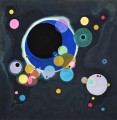Paintings > Art styles > Modern Art
 Modern art refers to artistic works produced from the 1860s to about the 1970s. Modern art begins with the heritage of painters like Vincent van Gogh, Paul Cézanne, Paul Gauguin, Georges Seurat and Henri de Toulouse-Lautrec all of whom were essential for the development of modern art. At the beginning of the 20th century Henri Matisse and several other young artists including the pre-cubist Georges Braque, André Derain, Raoul Dufy and Maurice de Vlaminck revolutionized the Paris art world with 'wild', multi-colored, expressive, landscapes and figure paintings that the critics called Fauvism.
Modern art refers to artistic works produced from the 1860s to about the 1970s. Modern art begins with the heritage of painters like Vincent van Gogh, Paul Cézanne, Paul Gauguin, Georges Seurat and Henri de Toulouse-Lautrec all of whom were essential for the development of modern art. At the beginning of the 20th century Henri Matisse and several other young artists including the pre-cubist Georges Braque, André Derain, Raoul Dufy and Maurice de Vlaminck revolutionized the Paris art world with 'wild', multi-colored, expressive, landscapes and figure paintings that the critics called Fauvism.Henri Matisse's two versions of The Dance marked a key point in his career and in the development of modern painting. It reflected Matisse's fascination with primitive art: the intense warm color of the figures against the cool blue-green background and the rhythmical succession of the dancing nudes convey the feelings of emotional liberation and hedonism.
Pablo Picasso made his first cubist paintings based on Cézanne's idea that all depiction of nature can be reduced to three solids: cube, sphere and cone. With the painting Les Demoiselles d'Avignon 1907, Picasso dramatically created a new and radical picture depicting a raw and primitive brothel scene with five prostitutes, violently painted women, reminiscent of African tribal masks and his own new Cubist inventions.
Analytic cubism was jointly developed by Pablo Picasso and Georges Braque, exemplified by Violin and Candlestick, Paris, from about 1908 through 1912. Analytic cubism, the first clear manifestation of cubism, was followed by Synthetic cubism, practised by Braque, Picasso, Fernand Léger, Juan Gris, Albert Gleizes, Marcel Duchamp and several other artists into the 1920s. Synthetic cubism is characterized by the introduction of different textures, surfaces, collage elements, papier collé and a large variety of merged subject matter.
The notion of modern art is closely related to Modernism.
Source: wikipedia
-
 $AU 198.85 ~ 780.47
$AU 198.85 ~ 780.47 -
 $AU 254.34 ~ 1,026.74
$AU 254.34 ~ 1,026.74 -
 $AU 270.80 ~ 1,476.17
$AU 270.80 ~ 1,476.17 -
 $AU 243.95 ~ 934.85
$AU 243.95 ~ 934.85 -
 $AU 247.19 ~ 963.46
$AU 247.19 ~ 963.46 -
 $AU 235.67 ~ 861.54
$AU 235.67 ~ 861.54 -
 $AU 260.84 ~ 1,801.08
$AU 260.84 ~ 1,801.08 -
 $AU 160.98 ~ 1,375.08
$AU 160.98 ~ 1,375.08 -
 $AU 1,272.00 ~ 1,668.00
$AU 1,272.00 ~ 1,668.00 -
 $AU 936.00 ~ 1,488.00
$AU 936.00 ~ 1,488.00 -
 $AU 720.00 ~ 1,690.49
$AU 720.00 ~ 1,690.49 -
 $AU 780.00 ~ 1,601.78
$AU 780.00 ~ 1,601.78 -
 $AU 1,126.86 ~ 1,894.98
$AU 1,126.86 ~ 1,894.98 -
 $AU 1,192.58 ~ 2,210.28
$AU 1,192.58 ~ 2,210.28 -
 $AU 483.89 ~ 959.12
$AU 483.89 ~ 959.12 -
 $AU 2,619.64 ~ 5,649.88
$AU 2,619.64 ~ 5,649.88


